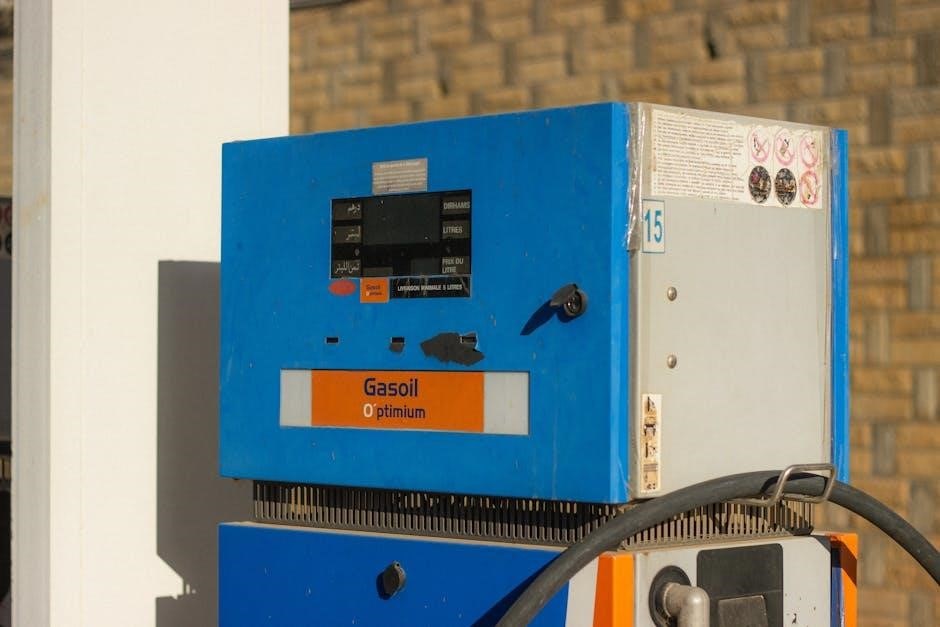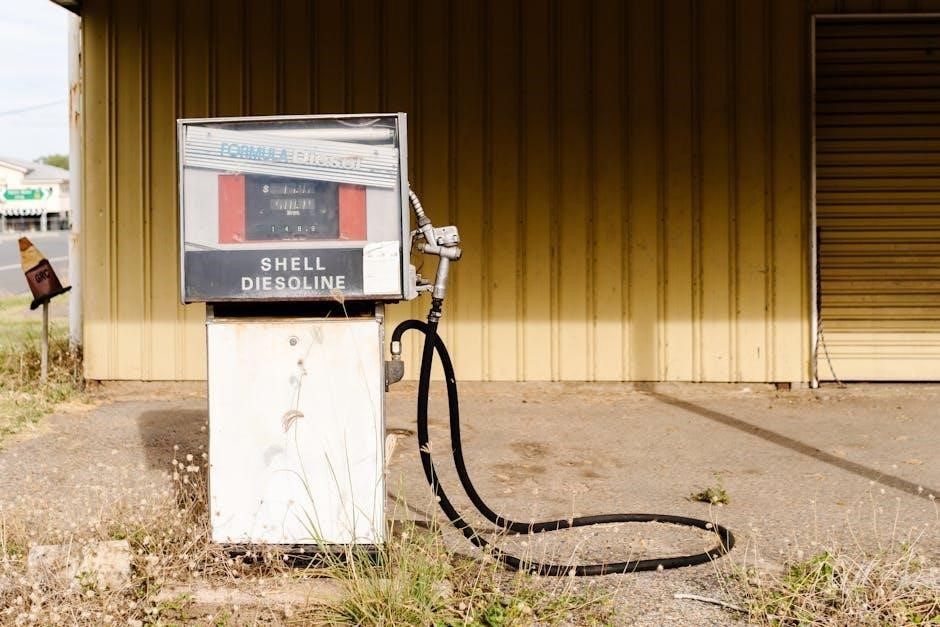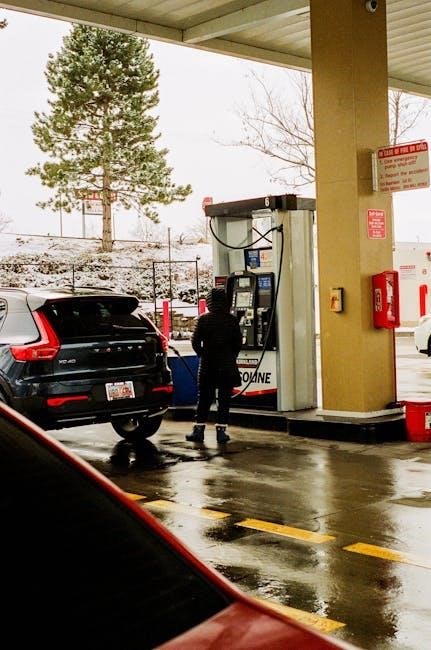cummins pt fuel pump manual pdf
Welcome to the Cummins PT Fuel Pump Manual, a comprehensive guide designed to help users understand, install, and maintain the PT fuel pump system. This manual covers essential topics such as installation, removal, troubleshooting, and regular maintenance to ensure optimal performance and reliability. By following the guidelines outlined in this manual, you can maximize the efficiency and longevity of your Cummins PT fuel pump, ensuring smooth engine operation. Refer to specific sections for detailed instructions and procedures.
Overview of the Cummins PT Fuel System
The Cummins PT fuel system is a sophisticated component designed to deliver fuel efficiently in diesel engines. It operates on a pressure-time fuel metering principle, ensuring precise fuel delivery based on engine demand. The PT fuel pump is the central component, responsible for pressurizing and metering fuel to the injectors. The system includes key elements like the gear pump, fuel lines, injectors, and control valves. Its simplicity and reliability make it a critical part of Cummins engines, providing consistent performance under varying load conditions. Regular maintenance, as outlined in the manual, is essential to maintain optimal functionality and prevent issues. Understanding the PT fuel system’s structure and operation is vital for troubleshooting and ensuring long-term engine reliability.

Understanding the Cummins PT Fuel Pump
The Cummins PT fuel pump is a critical component of the fuel system, operating on a pressure-time principle to meter fuel precisely for engine operation.

Structure and Function of the PT Fuel Pump
The Cummins PT fuel pump is a diesel distributor-type fuel injection pump designed to deliver fuel under high pressure to the engine’s cylinders. Its structure includes a gear pump, which generates the initial fuel pressure, and a fuel metering valve, responsible for controlling the timing and quantity of fuel delivery. The pump also features a shut-down valve to halt fuel flow when the engine is turned off. The PT pump operates on a pressure-time fuel-metering principle, ensuring precise fuel delivery based on engine speed and load. The pump’s internal components, such as the plunger and barrel assembly, work together to meter and pressurize fuel, which is then distributed to the injectors for combustion. Proper functioning of the PT pump is critical for optimal engine performance, efficiency, and emissions control.
Key Components of the PT Fuel System

The Cummins PT fuel system consists of several critical components that work together to ensure efficient fuel delivery. The gear pump generates initial fuel pressure, while the fuel metering valve regulates fuel flow based on engine demand. The shut-down valve halts fuel delivery when the engine is turned off, preventing fuel leakage. Additionally, the system includes injectors that spray fuel into the engine cylinders under high pressure. The fuel supply line connects the fuel tank to the pump, ensuring a steady fuel supply. Lastly, the governor controls engine speed by adjusting fuel delivery. Each component plays a vital role in maintaining precise fuel metering and overall engine performance. Proper functioning of these parts ensures efficient combustion, power, and fuel economy in Cummins engines.

Cummins PT Fuel Pump Manual: Key Sections
This manual is divided into essential sections, including operating principles, installation instructions, maintenance guidelines, and troubleshooting procedures. Each section provides detailed guidance for optimal performance.
Operating Principles of the PT Fuel Pump
The Cummins PT fuel pump operates based on a pressure-time fuel metering principle, ensuring precise fuel delivery. It utilizes a fixed opening to regulate fuel flow, simplifying the system. The gear pump generates fuel pressure, which is then metered according to engine speed and load. Fuel is injected into the cylinders through high-pressure injectors, while excess fuel returns to the tank. The system also features a shut-down valve to halt fuel flow when the engine stops. Understanding these principles is crucial for proper operation, maintenance, and troubleshooting, as detailed in the manual.
Disassembly, Inspection, and Reassembly Procedures
The manual provides detailed steps for disassembling, inspecting, and reassembling the Cummins PT fuel pump. Start by cleaning the exterior to ensure a contamination-free environment. Remove the electrical connections and mounting components, then carefully dismantle the pump, noting the sequence of parts. Inspect each component for wear, damage, or corrosion, replacing worn parts as needed. During reassembly, align components precisely and tighten bolts to specified torque values. Lubricate moving parts to prevent friction. Proper reassembly ensures optimal performance and longevity. Follow the manual’s guidelines to avoid errors and maintain system integrity.
Testing and Diagnostic Procedures
Testing and diagnostics are critical for ensuring the Cummins PT fuel pump operates efficiently. Begin by checking the gear pump while cranking the engine; the gears must turn to confirm proper function. If the gears fail to rotate, remove the fuel pump for further inspection. Use a pressure gauge to measure fuel pressure against specifications. Listen for unusual noises, such as whining or grinding, which may indicate worn components. Visually inspect fuel lines and connections for leaks or damage. For diagnostic steps, refer to the manual’s troubleshooting section. Common issues include low fuel pressure, air leaks, or a seized gear pump. Addressing these problems promptly ensures reliable engine performance and prevents further damage. Always follow the manual’s guidelines for accurate testing and diagnostics.

Installation and Removal Instructions
Installation and removal of the Cummins PT fuel pump require careful preparation. Clean the exterior of the injection pump and mounting surfaces. Remove electrical connectors and align the pump properly. Follow manual guidelines for safe and effective installation or removal to ensure proper engine function.
Step-by-Step Guide for PT Fuel Pump Installation
Installing the Cummins PT fuel pump involves several precise steps; Begin by cleaning the exterior of the injection pump and mounting surfaces to ensure a proper seal. Next, remove any electrical connectors and align the pump with the engine’s mounting points. Secure the pump using the specified bolts, tightening them in the recommended sequence. Reconnect the electrical connectors and fuel lines, ensuring all connections are tight to prevent leaks. Finally, test the system by cranking the engine to confirm proper fuel flow and operation. Always refer to the manual for specific torque values and safety precautions to avoid damage or injury. Following these steps ensures a successful installation and optimal performance of the PT fuel pump.
Removal Procedures for Maintenance and Repair
Removing the Cummins PT fuel pump requires careful steps to ensure safety and avoid damage. Start by disconnecting the negative battery terminal to prevent electrical hazards. Clean the exterior of the pump and surrounding areas to remove dirt and debris. Disconnect the electrical connectors and fuel lines, taking note of their positions for reinstallation. Remove the mounting bolts in the specified order, typically in a star pattern, to avoid warping the pump or engine block. Gently pull the pump away from the engine, taking care not to damage the gasket or mounting surfaces. Once removed, inspect the area for any remaining gasket material and clean it thoroughly before reassembly. Always refer to the manual for specific torque values and reinstallation procedures to ensure proper function and prevent leaks.
Troubleshooting the Cummins PT Fuel Pump
Troubleshooting the Cummins PT fuel pump involves identifying common issues like low fuel pressure or a non-turning gear pump. Check electrical connections, fuel supply, and for air leaks. Refer to the manual for diagnostic steps and repair procedures to address these problems effectively.
Common Issues and Diagnostic Steps
Common issues with the Cummins PT fuel pump include low fuel pressure, failure to start, and excessive noise. Diagnosing these problems begins with checking the gear pump operation while cranking the engine. If the gears do not turn, the pump may need to be removed for further inspection. Another common issue is air in the fuel system, which can cause erratic performance. Always ensure the fuel supply lines are clear and properly connected. Additionally, electrical connections should be inspected for damage or corrosion. Refer to the manual for detailed diagnostic steps and repair procedures to address these issues effectively and ensure proper pump functionality.
Resolving Fuel Pump-Related Engine Problems
Resolving engine problems linked to the Cummins PT fuel pump involves identifying and addressing root causes. If the engine fails to start, check for low fuel pressure or a seized gear pump. Ensure the shut-down valve is not stuck or clogged. For excessive noise, inspect the pump for worn components or misalignment. Erratic performance may indicate air in the system or faulty electrical connections; Always refer to the manual for step-by-step diagnostics and repair procedures. Adjustments, such as resetting the idle speed or throttle position, can often resolve issues. Regular maintenance, like cleaning and lubricating moving parts, prevents premature wear. If problems persist, consider replacing damaged components or consulting a certified technician for professional assistance.
Maintenance and Adjustment Guidelines
Regular cleaning of the pump exterior and mounting surfaces prevents contamination. Lubricate moving parts periodically to avoid wear. Inspect for wear and tear, replacing components as needed. Ensure electrical connections are secure for optimal performance. Adjustments should align with manual specifications to maintain efficiency and reliability.
Regular Maintenance Tips for the PT Fuel Pump
Regular maintenance of the Cummins PT fuel pump is crucial for ensuring optimal performance and longevity. Begin by cleaning the exterior of the pump and its mounting surfaces to prevent contamination. Inspect all electrical connections and ensure they are secure to avoid disruptions in fuel supply. Lubricate moving parts periodically to reduce friction and wear. Additionally, check the fuel lines for any signs of damage or leaks, replacing them if necessary. The gear pump should be inspected while the engine is cranking to ensure proper rotation. If the gears do not turn, remove the pump for further examination. Regularly reviewing and following the manual’s guidelines will help maintain the pump’s efficiency and prevent potential issues before they arise.

Adjustment Procedures for Optimal Performance
Proper adjustment of the Cummins PT fuel pump is essential for achieving optimal engine performance. Start by ensuring the fuel pump is set to the correct idle speed, as specified in the manual. Manually position the pump at mid-throttle to verify proper fuel flow. Adjust the shut-down valve if necessary to maintain consistent operation. Regularly check and adjust the injector and valve clearances to ensure precise fuel metering. Lubricate all moving parts to reduce friction and wear. Refer to the manual for specific torque values and adjustment sequences. By following these procedures, you can fine-tune the PT fuel pump for enhanced efficiency, reliability, and overall engine performance. Proper adjustments will also help prevent potential issues and extend the lifespan of the fuel system components.
The Cummins PT Fuel Pump Manual provides essential guidelines for optimal performance, maintenance, and troubleshooting. Adhering to these instructions ensures reliable engine operation and extends system longevity.
Importance of Following the Manual Guidelines
Following the Cummins PT Fuel Pump Manual guidelines is crucial for ensuring proper installation, maintenance, and troubleshooting of the fuel pump system. Adhering to the instructions helps prevent damage to components, reduces the risk of engine failure, and ensures optimal performance. The manual provides detailed procedures for disassembly, inspection, and reassembly, as well as diagnostic steps for common issues. Proper adherence to torque specifications, electrical connections, and fuel line routing is essential for safety and efficiency. By following the manual, users can avoid costly repairs and extend the lifespan of the PT fuel pump. Regular maintenance, as outlined, prevents unexpected breakdowns and ensures reliable engine operation. Always refer to the manual for specific adjustments and testing procedures to maintain peak performance and avoid potential hazards.
